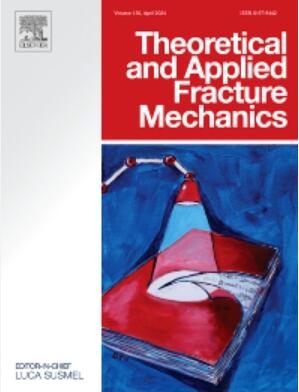Dynamic fracture simulation of flawed rocks under varying loading rates by the rate-dependent SW-DVIB model combined with EPM
IF 5
2区 工程技术
Q1 ENGINEERING, MECHANICAL
引用次数: 0
Abstract
The mechanical characteristics of rocks are substantially influenced by their strain rate, and the intricacy of rock dynamic failure is compounded by the presence of flaws within the rock structure. In this study, a rate-dependent Stillinger-Weber (SW) potential based discretized virtual internal bond (DVIB) model is proposed and integrated with the element partition method (EPM) to simulate the dynamic fracture of flawed rocks under varying loading rates. The rate-dependent SW potential, which is an improvement of the conventional trilinear damage potential, is produced by altering material properties to account for strain rate effects. A series of Split Hopkinson Pressure Bar (SHPB) experiments were simulated on various flawed specimens, including single-flawed, parallel-flawed and cross-flawed specimens, to validate the accuracy of our model for simulating rock dynamic fracture. The simulated findings demonstrate that all specimens’ dynamic strengths increase as the strain rate increases. For single-flawed and parallel-flawed specimens, the dynamic strength initially decreases and then increases as the flaw angle increases. Asymmetric cross-flawed specimens exhibit higher dynamic strengths compared to their symmetric counterparts. An increase in strain rate can exacerbate the dynamic failure characteristics and failure degree of different kinds of flawed specimens. The single-flawed and parallel-flawed specimens’ tensile failure characteristics deteriorate and their shear failure characteristics rise with an increase in flaw angle. The failure pattern of parallel-flawed specimens is more sensitive to changes in flaw angle than to variations in flaw spacing. Under the same strain rate conditions, the failure pattern of asymmetric cross-flawed specimen is more complex than that of symmetric cross-flawed specimen. The comparison between the simulated and experimental results confirms that the developed rate-dependent SW-DVIB model combined with EPM proves to be an effective tool for simulating the dynamic fracture behavior of flawed rocks under varying loading rates.
求助全文
约1分钟内获得全文
求助全文
来源期刊

Theoretical and Applied Fracture Mechanics
工程技术-工程:机械
CiteScore
8.40
自引率
18.90%
发文量
435
审稿时长
37 days
期刊介绍:
Theoretical and Applied Fracture Mechanics'' aims & scopes have been re-designed to cover both the theoretical, applied, and numerical aspects associated with those cracking related phenomena taking place, at a micro-, meso-, and macroscopic level, in materials/components/structures of any kind.
The journal aims to cover the cracking/mechanical behaviour of materials/components/structures in those situations involving both time-independent and time-dependent system of external forces/moments (such as, for instance, quasi-static, impulsive, impact, blasting, creep, contact, and fatigue loading). Since, under the above circumstances, the mechanical behaviour of cracked materials/components/structures is also affected by the environmental conditions, the journal would consider also those theoretical/experimental research works investigating the effect of external variables such as, for instance, the effect of corrosive environments as well as of high/low-temperature.
 求助内容:
求助内容: 应助结果提醒方式:
应助结果提醒方式:


